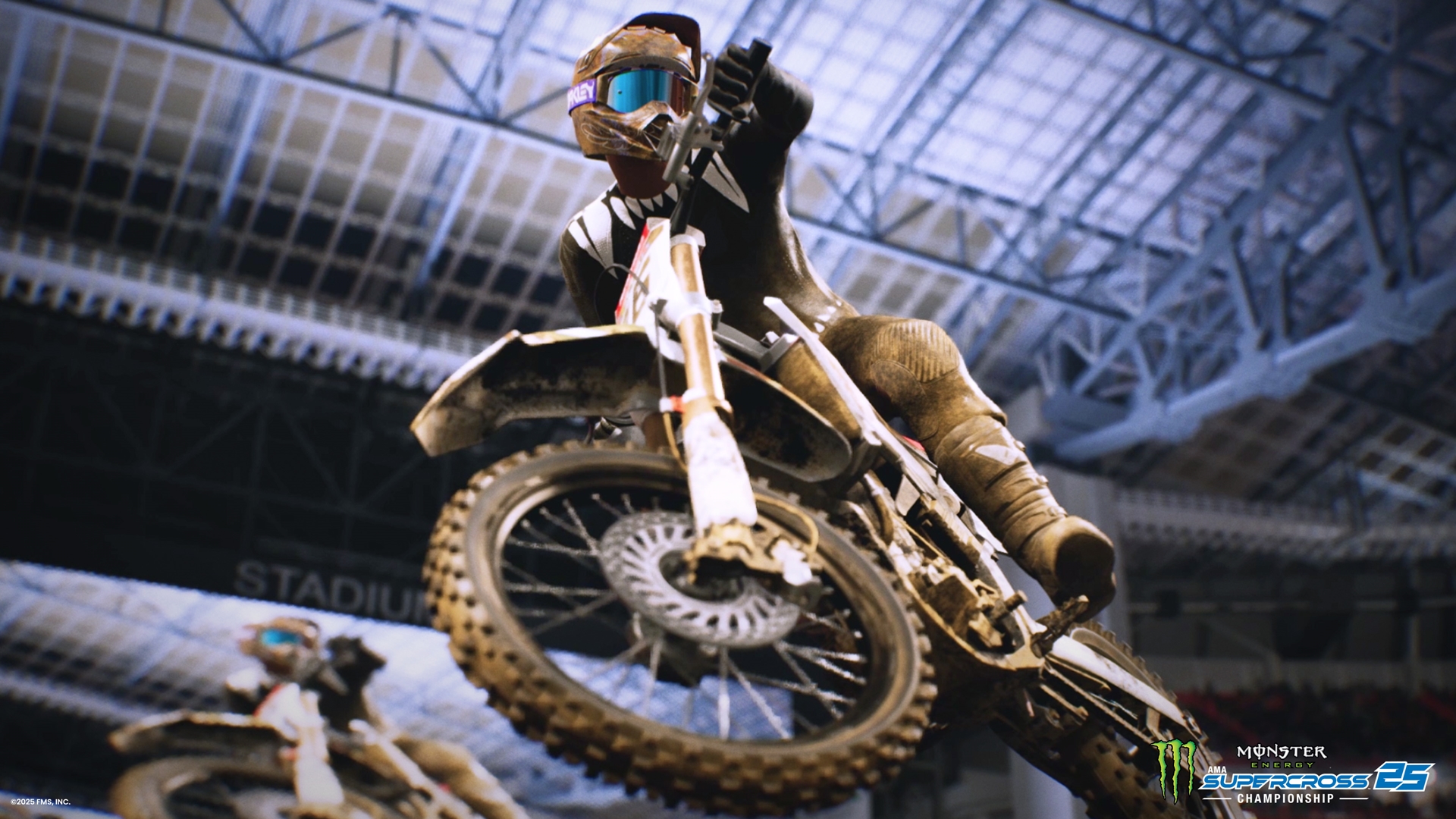
After a year’s hiatus, the dedicated motorbike racer returns with an updated version of “Monster Energy Supercross 25“. Despite being billed as a reboot, this latest installment seems to be missing some significant updates and improvements that many enthusiasts were anticipating. However, is “Monster Energy Supercross 25” the pinnacle of the series and worth spending $59.99 on? Let’s delve into what the newest addition to the supercross saga brings to the table.
To begin with, it’s essential to note the focus on how the bike handles while you ride. Supercross 25 offers an engaging blend of arcade and realistic bike racing. Unlike games such as Excitebike or Mario Kart, reckless cornering won’t end well; expect a fall into the dirt if you don’t pay attention. In line with previous Supercross games, controlling your bike involves two sticks: the left stick for steering and tilting the bike, while the right stick adjusts the rider’s body weight by leaning in and out of turns. Balancing your weight during turns is crucial to keep traction and prevent slipping. It’s also worth mentioning that this game doesn’t heavily emphasize tricks. While players can perform whips and scrubs for better cornering, there aren’t many extreme sports flourishes beyond that.
What I truly enjoy is navigating my bike over whoops (a series of small, consecutive bumps), as this provides a satisfying resistance. The enhanced haptic feedback on the DualSense controller effectively simulates the varying track textures. Balancing the rhythm through sequences of jumps and turns can be both frustrating and fulfilling, and this game, Supercross 25, does a good job of mirroring that authentic experience from the real sport.
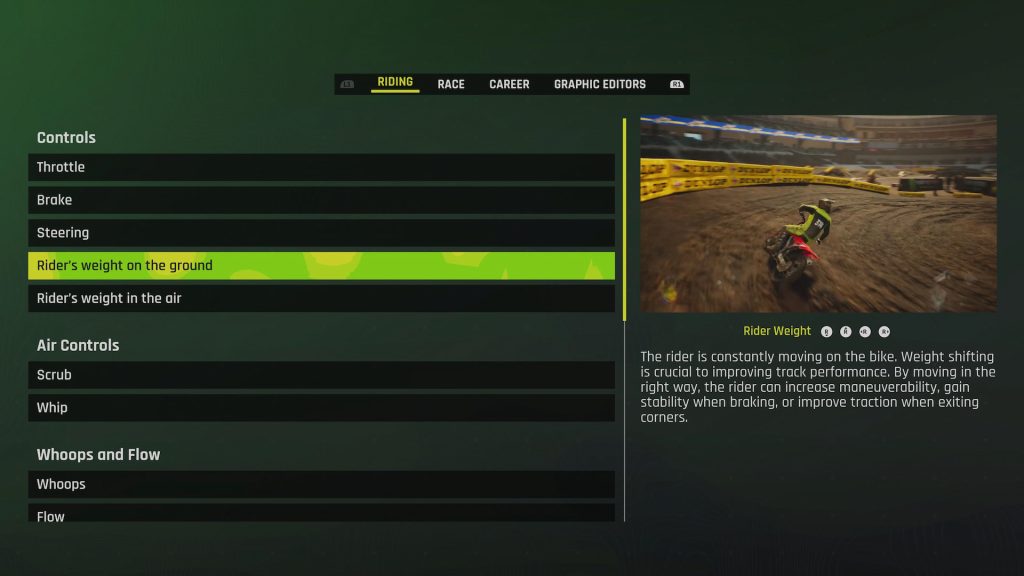
Maintaining a balanced weight during turns is essential for maintaining grip and preventing yourself from skidding or losing control.
In the world of Supercross 25, one aspect that significantly boosts realism is the dynamic ruts and ground deformation on the dirt tracks. At first, I believed this feature to be merely a marketing trick, but upon playing, I realized the ruts truly demand constant vigilance from the rider as they adapt around the circuit. Unfortunately, I fell numerous times due to deep ruts sending my bike off its intended path. This innovative terrain deformation element adds authenticity to the series, pushing it towards a more simulation-like experience in a beneficial way.
Just as grooves in a road influence bike handling, weather also influences bike stability on outdoor tracks. You can customize weather conditions for your own tracks, while career events come with predetermined track conditions. Although I didn’t observe weather changes during races, it’s beneficial that rain makes the track slippery not only for the player but also for the AI.
As a dedicated gamer, I value the authenticity that real-world elements like ruts and weather bring to racing games, enhancing the overall experience. However, when it comes to handling and cornering mechanics, I can’t help but feel underwhelmed. Whether I’m navigating through a sharp hairpin or making minute adjustments, the turning feels unintuitive and lacks the fun factor that should be inherent in such situations.
In real life, maneuvering a bike at high speeds on rough terrain isn’t exactly intuitive, but this game doesn’t seem to capture it convincingly enough. The persistent understeer during turn-ins is a recurring issue, making the gameplay feel more like a struggle against initial understeer followed by snap oversteer to correct it. Maintaining control on the track can be challenging and frustrating, especially for beginners.
Players who weren’t fond of the physics in Supercross 6 might find themselves sharing similar sentiments with this new release; the stiffness remains largely unchanged from its predecessor.
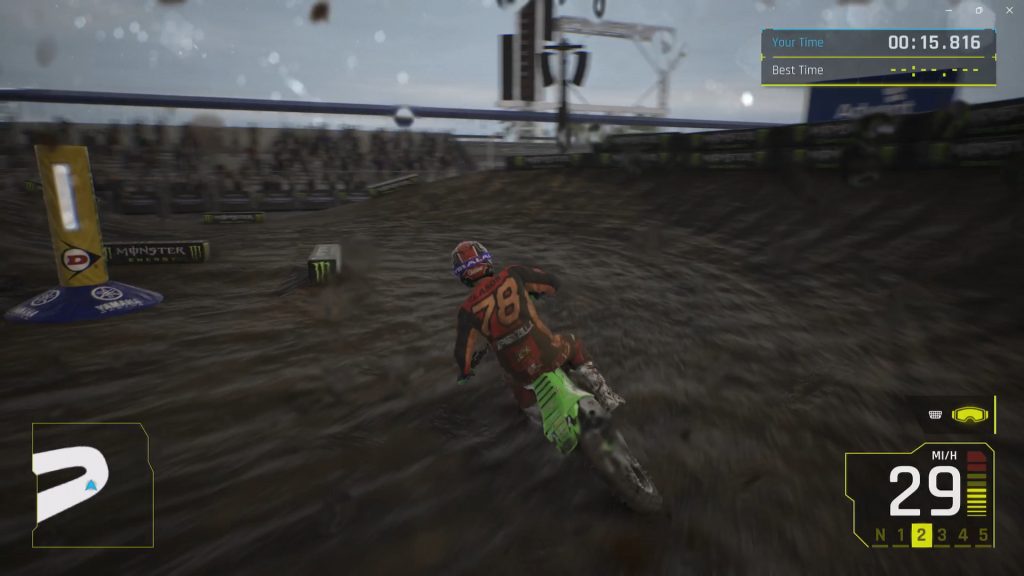
You’re able to adjust the weather conditions for outdoor tracks yourself, but keep in mind that career events already have specific track conditions set.
Although opinions on the handling of the bikes may vary, it’s clear that the animations are merely average at their best, with the rider’s movements appearing quite stiff compared to previous versions. For instance, even during mid-air stunts, there’s scarcely any body movement, despite shifting weight. Regrettably, the developers seem to have neglected animation upgrades in this edition, which diminishes the overall impact of the visual enhancements. The game certainly looks impressive, with details like rain puddles and changing dirt patterns on the tracks. However, it seems that the visceral experience has been compromised, especially when it comes to features like mud splashing and loose rider movement. Given that this is the first Unreal Engine 5 game in the series, I was expecting more in terms of realism.
Regarding tracks, this game offers an assortment that’s quite satisfactory. While it has the same number (17) as the previous version, fresh tracks like Glendale Stadium are a delightful inclusion. For nature enthusiasts, there are 13 outdoor tracks available, which can be customized with weather settings. Unfortunately, the roster of riders has been decreased from 80 in the last game to only 65. Although a slight decrease is acceptable given this is a reboot, the lack of distinct differences in bike/rider handling doesn’t make up for it. Each rider feels similar to control, and the only variation between bikes is their sound and stats.
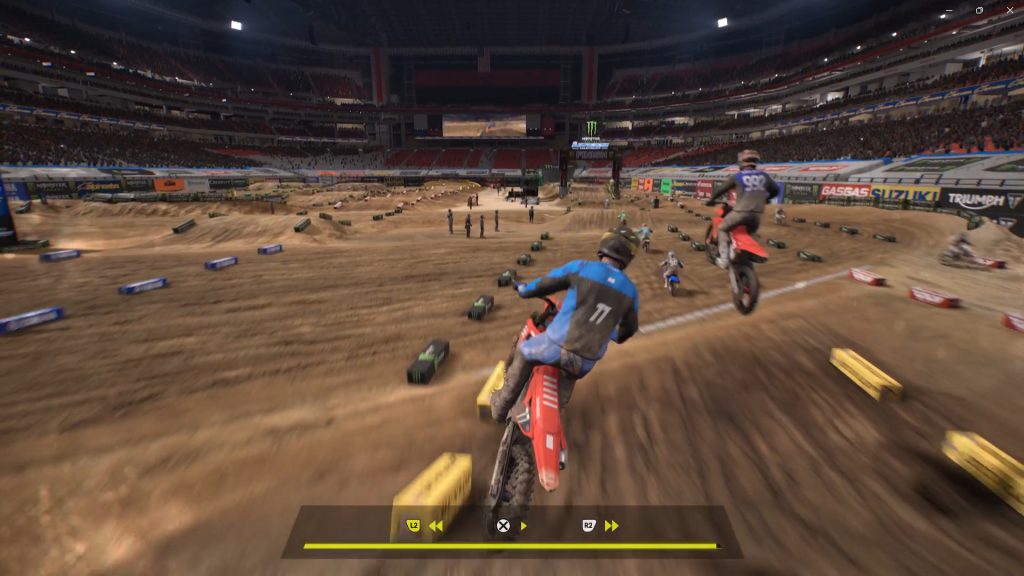
“The rider’s rigid movements look almost identical to past entries.”
Let’s dive into what these bikes are used for and explore different game modes. First up, the tutorials. This time, instead of the tutorial being integrated with Career, it’s been moved to a separate menu. I can’t quite understand why they thought a reboot was the right moment to conceal the Supercross Academy tutorial. As a novice in the world of supercross racing, I found the learning experience for this mode underwhelming. They barely scratched the surface with tutorialization, offering just a list of tasks to complete without any explanation of fundamental concepts or advanced controls. If you’re seeking an actual explanation of what ‘whoops’ are, you’ll need to navigate to a separate text menu for more detailed explanations. I wouldn’t recommend this game for newbies entering the supercross racing game scene due to the almost non-existent onboarding and poor tutorialization.
As a die-hard gaming enthusiast, I was bummed out that The Online Hub wasn’t accessible during the review period, but based on what I’ve gathered, it seems to have a familiar feel reminiscent of Supercross 6. Fortunately, offline split-screen mode is an option for those without PS Plus or Xbox Live subscriptions. The single-player modes consist of Single Event, Rhythm Attack, Time Attack, and Championship. If you’re feeling creative, the Workshop offers a chance to design custom suit graphics, bike liveries, and even create your own tracks using the track editor.
As a seasoned gamer, I’ve dabbled with numerous track editors throughout my gaming journey, but this one leaves me scratching my head. It’s not exactly user-friendly, and it seems to lack the depth that I crave in a creative tool.
Firstly, the selection of options to play around with is rather limited. There are only four tracks to choose from – two outdoor stadiums and two indoor ones. Unfortunately, there’s no option to zoom in or out while editing, which makes fine-tuning a real challenge.
I can accept the variety of straightaways and jumps, but the size tool leaves much to be desired. Jumps only have three size options, none of which are impressive enough for my taste. If you’re hoping to create a massive 20-foot jump, I’m afraid that dream is out of reach; your choices are limited to either a tiny bump or a standard jump.
It’s also puzzling that we can’t adjust the size of walls or step-up tables. I find myself wondering why bother with this track editor when the number of options it offers the player is so slim.
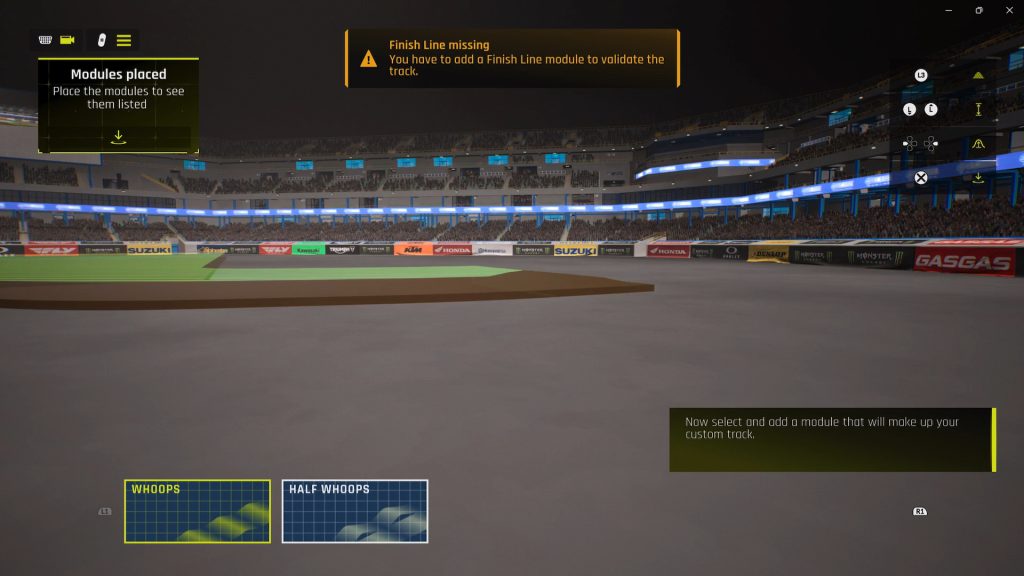
“There’s just not that many fun options to experiment with in this track editor.”
Regardless of how you choose to play, you’re constantly accumulating experience that helps advance bicycles and riders. Each level-up provides a particular component or bike as a reward. The way rewards are structured is similar to many seasonal rotations in live services, except without the ‘live service’ aspect. Sometimes I can’t help but feel that game publishers are becoming too complacent with progression systems, resorting to replicating the live service model even when the game itself isn’t a live service. However, let’s move on.
To wrap it up, there’s the Career Mode, which won’t surprise you much if you’ve played a sports game recently due to its familiar structure. You start off as a novice with no fame or fanbase in the ‘Futures’ category. If you manage to place among the top 15 in subsequent races, you’ll be promoted to the ‘Rookie’ category, where you can pick a team from either the 250 East or 250 West division. As you race, other teams may express interest in partnering with you. Social media plays a part here too, as your follower count influences your reputation. Achieving objectives and performing well in races increases your followers. Additionally, you’ll receive messages from fellow riders and the media, offering opportunities to either tease them or win their favor. I must confess, I’m weary of the repetitive career modes in sports games, and Supercross 25 doesn’t exactly fill me with hope about future improvements in this aspect. The social media Career features seem rather predictable and shallow at this point.
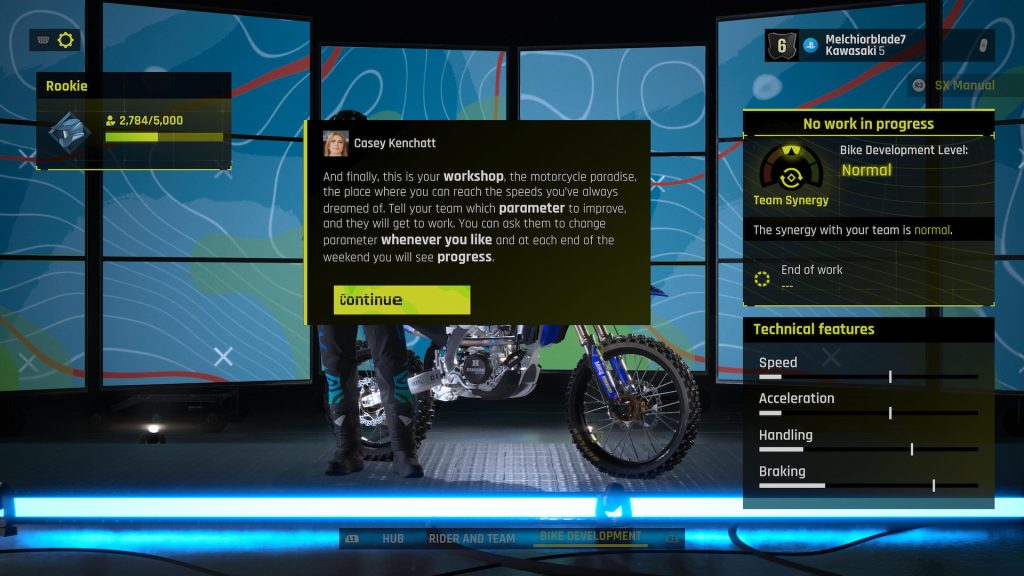
“A high team synergy pushes your Bike Development further, improving various stats.”
Teamwork harmoniousness holds some appeal, even though it’s been featured in numerous sports games already. A strong team synergy propels your Bike Development, enhancing statistics across Speed, Acceleration, Handling, and Braking attributes. Different teams prioritize certain stats over others, and they also offer the opportunity to ride their distinctive bike brands.
Progression in your career is likened to a sequence of ‘Acts’, each featuring a rival who taunts you via private messages and competes fiercely during races. By the way, the AI has seen some enhancement compared to the previous game, though it’s just a minor improvement. The racers continue to make thoughtless moves like jumping on your head or crashing into you due to poor route planning. Even in challenging modes, they don’t seem to adjust their path or yield, but they do move more smoothly and are tough opponents if you’re not an experienced player.
Initially, I was eager to fall in love with a bike racing game once more, banking on Supercross 25 to rekindle that excitement. However, the game’s physics model failed to deliver fun or intuitive interaction. While there might be elements of enjoyment for devoted supercross enthusiasts who can navigate past the initial hurdles, for most players, there’s little to savor. The game veers towards a more simulation-style experience with its advanced track deformation, but fails to provide a sense of accomplishment upon mastery due to clumsy physics and unimpressive AI.
This game was reviewed on the PlayStation 5.
Read More
- OM/USD
- Jellyrolls Exits Disney’s Boardwalk: Another Icon Bites the Dust?
- Carmen Baldwin: My Parents? Just Folks in Z and Y
- Solo Leveling Season 3: What You NEED to Know!
- Jelly Roll’s 120-Lb. Weight Loss Leads to Unexpected Body Changes
- Despite Strong Criticism, Days Gone PS5 Is Climbing Up the PS Store Pre-Order Charts
- Moo Deng’s Adorable Encounter with White Lotus Stars Will Melt Your Heart!
- The Perfect Couple season 2 is in the works at Netflix – but the cast will be different
- Joan Vassos Reveals Shocking Truth Behind Her NYC Apartment Hunt with Chock Chapple!
- Lisa Rinna’s RHOBH Return: What She Really Said About Coming Back
2025-04-08 15:14